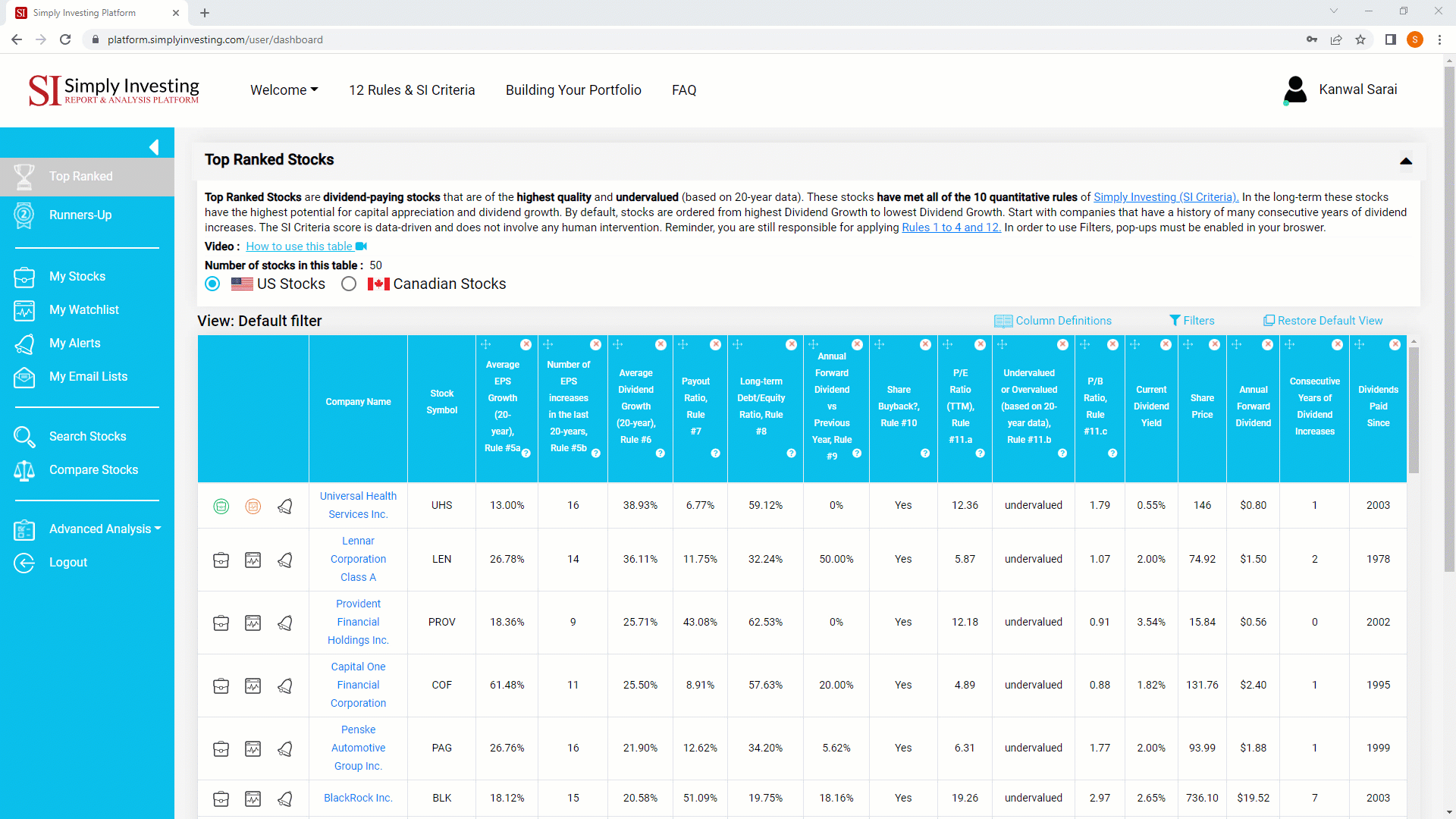Helping You Earn More by Investing in Dividend Stocks
You can grow your money reliably, regardless of what happens in the economy. Watch the video to learn how to get started today!
Are You New to Investing?
TAKE THE INVESTING COURSE

The online Financial Freedom Investing Course is the easiest way to learn how to find quality dividend paying stocks when they are priced low. Build a portfolio that generates growing passive income each year. You can apply these strategies to any stock market in the world.
Are You An Experienced Investor?
USE THE INVESTING PLATFORM

The Simply Investing Platform does the work for you. Each day it analyzes over 6000 common stocks in the US and Canada, and applies our SI Criteria, giving each a stock a grade out of 10. Then the Platform provides you with a list of the best quality stocks to consider, and the ones to avoid.
Featured In





One Coaching Call with Kanwal Saved Tracy $1,398,316
Tracy a 45 year old software manager, had accumulated a $300,000 portfolio consisting of 25 mutual funds, index funds and ETFs.
With her existing portfolio she would be losing:
- $67,540 in fees after 10 years
- $224,376 in fees after 20 years
- $1,398,316 in fees after 40 years
Are you making the 5 most common investing mistakes?
Download our free guide and learn how to save your hard earned money.
Hi, I'm Kanwal.
I help people just like you to earn more money, save time, and reduce your risk.
With more than 20 years of experience as a dividend value investor, I am passionate about demystifying the world of investing. With Simply Investing I give you the tools & knowledge to become a successful dividend investor.
From 9 years to 65 years old, since 2007 my course has taught people in over 30 countries how to create their own stream of growing passive income by investing in quality dividend stocks, and has helped them save thousands of dollars in fees.
Frequently Asked Questions
Frequently Asked Questions
In the course I use examples of Canadian and U.S. stocks, but you can certainly apply the same concepts to stocks anywhere in the world.
I have customers from Azerbaijan, Sweden, U.S., Thailand, Tanzania, Switzerland, South Africa, Singapore, New Zealand, Romania, Qatar, Norway, Malaysia, India, Hungary, UK, France, Czech Republic, Brunei, Australia, and Canada who have completed the course and successfully applied the dividend value investing principles to stocks trading in their own country.
Currently the Platform only tracks stocks in the US and Canada. Therefore it is valuable to anyone investing in US or Canadian stocks.
If you would like to apply the 12 Rules of Simply Investing to international stocks you should take the investing Course. The Course comes with a spreadsheet that you can use to analyze international stocks.
The 12 Rules of Simply Investing are designed to help you earn more, reduce your risk and save you time. The rules will prevent you from making expensive investing mistakes.
Before you invest in any company (stock) make sure it passes ALL of the 12 Rules listed below:
1. Do you understand the product or service offered by the company?
2. Will people still be using this product or service in 20 years?
3. Does the company have a low-cost durable (lasting) competitive advantage?
4. Is the company recession proof?
5. Ensure the company is profitable, check the following two EPS parameters:
a. 20-year average EPS growth must be at least 8% or more.
b. The EPS must have increased at least 8 times in the last 20-years.
6. 20-year average dividend growth must be at least 8% or more.
7. Payout ratio must be 75% or less.
8. Debt must be 70% or less.
9. Has there been a recent dividend cut? Avoid companies with a recent dividend cut.
10. Does the company actively buy back its shares?
11. Ensure the stock is priced low (undervalued):
a. P/E ratio must be 25 or less.
b. Current dividend yield must be higher than its (20-year) average dividend yield.
c. P/B ratio must be 3 or less.
12. Keep your emotions out of investing.
The 12 Rules of Simply Investing are time tested and designed to keep you from making mistakes. Investing really can be this simple.
No, you do not need to buy the Simply Investing Course in order to subscribe to the SI Platform.
The SI Platform subscription can be purchased independently.
![]()
Disclaimer: Kanwal Sarai is not an investment advisor, certified financial planner, or broker. Kanwal Sarai is an educator and dividend value investor, and has been for more than two decades. The information provided here is for educational purposes. My opinions are based upon information that I consider reliable, but I do not warrant its completeness or accuracy, and it should not be relied upon as such. The statements and opinions on this newsletter/course/report/video/website/presentation are subject to change without notice. I may personally hold securities mentioned in this course/website/report/video/newsletter. The final decision to buy or sell any stock is yours; please do your own due diligence. Stock buy or sell decisions are based on many factors including your own risk tolerance. When in doubt please consult a professional advisor. No advice on the buying and selling of specific securities is provided. Past performance is not a guarantee of future results. You should not rely on any revenue, sales, or earnings information we present as any kind of promise, guarantee, or expectation of any level of success or earnings. Your results will be determined by a number of factors over which we have no control, such as your financial condition, experiences, skills, level of effort, education, and changes within the market. The names of actual companies or products mentioned herein may be the trademarks of their respective owners. View the complete Terms of Use.






